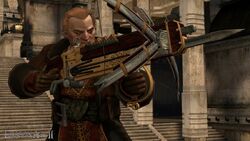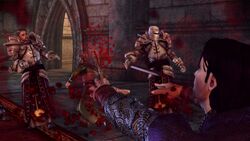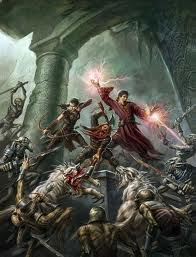Dragon Age III is still a ways off, so I decided to continue the perpetual rant of things I didn't like about Dragon Age II, in the extremely idealistic and unrealistic hope that BioWare reads this and realises what needs to be removed, and what needs to be added. I'm trying to be optimistic here, but I'm worried that their tendency to simply remove anything that isn't perfect, instead of actually improving it, will override all else.
Here's hoping.
For Each Item, a Story
“Somewhere on the field there is a bewildered knight fighting with his dinner fork. Pity him.” ―Description for Ser Garlen's Sword.
Oh, item descriptions, how I miss thee! Maybe it's just me, but one of the little things I loved in Dragon Age: Origins was that every weapon and armour piece had its own description. It may not seem like much, but they were still entertaining little titbits, and I loved that attention to detail that seemed lost in the sequel. It was always fun to get some ancient artefact, and learn its mysterious history, or just how badass it was. Those little bits of text fleshed out the game's world, even if it was just a little. A truly deep game world is made of hundreds of stories and should be rich with lore. Giving us little fragments-the legends, the tales of heroism and so forth-made Dragon Age: Origins feel all the more unique, because every item had a story to tell. That's the great thing about these kinds of open-ended RPG's. We're given a plethora of unique and interesting stories to seek our teeth into, and each item in the game can tell a different one. When Dragon Age III: Inquisition hits us, I hope they decide to give every item a description, whether it be generic, heroic, or hilarious.
To be fair, Dragon Age II did have a few, but not every item got a good description. Some of the more important items have codex entries, which is fine, but I really would have liked to see every item get this treatment. This may be a bit annoying however, so a simple examination option would be much better. This removal is part of a larger BioWare problem: streamlining. Now, I have no problem with streamlining, so long as it is done right. When you streamline too much, the game becomes a casual mess that no one can enjoy. The Dragon Age saga is/was made for RPG fans, and thus, should be deeper than most games.
Blood and Gore Galore!
“Decapitating people is like sex. Do it right, and there's no feeling like it in the world. Do it wrong, and you just end up getting messy and sticky. ” ―
IsabelaMe
Here's another small albeit nice aesthetic touch: Messy kills.
There's nothing wrong with a little flair in combat. Those seemingly small little titbits? They are what people appreciate the most. Messy kills were visceral, brutal, gruesome, and very satisfying. When the Elder Scrolls V: Skyrim added kill cams, I was pretty damn excited. Those moments of sheer badassery made my character feel even more awesome. It's simple, yet satisfying, and its absence from the sequel made me quite sad. It felt like that little something extra was just missing. Now, I really did like the combat system from Dragon Age II. I liked it a lot. It's one of the things they should definitely keep when moving forward with the next sequel. Despite a few minor kinks, the only real major change I would make is putting messy kills back in.
Crazy for Crossbows
I know this might be a minor gripe, but why couldn't we use crossbows in Dragon Age II? Is it because they fire too slowly? I can understand that, but then again, Varric also has a special one, so why can't we? Surely they could have found some way to make it work? Maybe, maybe not. It's one of those things I really missed from the first game, but they may have had good reasons. On the one hand, Varric probably wouldn't have been as special if everyone and their mother had a repeating crossbow. On the other hand, Varric is pretty badass on his own.
The Simple Joy of being a Fashionista
One of the fun parts of an RPG is being able to play dress up with all of your friends, whether they like it or not. Well, that's kind of messed up, but you get my point.
There's a lot of cool armour and clothing available in Dragon Age II, but not all of it is available to the player. Most of the DLC items for each class is completely useless to Hawke, because they can only equip items for their own class. I'll complain more on that later, but the fact remains that my rogue has a worthless set of heavy armour, and I cannot equip it on anyone. Whereas in Dragon Age: Origins I could fully customise my friend's armour sets completely, I can only customise the jewellery of my party.
Instead of giving us more control, it's taken away. BioWare did the same thing with Mass Effect 2, so this isn't an entirely new concept for them. Compare this to The Elder Scrolls V: Skyrim, which gave improved follower customisation over its sequel. That's how it's supposed to be done; a sequel shouldn't give us less opportunities and features, it should give us more.
Specilisation Streamlining
“But you are a blood mage.” ―The Warden, to Anders
Here's where streamlining gets taken too far. Specialisations in Dragon Age: Origins were something... well, special. They were unlocked based on our choices, and how much we explored the world. We could learn them through tomes, teachers, and deals with demons. They could change our play style, and could even be mentioned in dialogue. Now, there was always room for improvement; being a blood mage should have had more impact on the story, but it was a good start. The sequel should have taken it further. After all, the point of a sequel is to improve upon the original, right?
Dragon Age II didn't do that. Instead, it further segregated story and gameplay. Despite how prevalent blood magic is throughout the game, Hawke can slit his wrists, using their blood as a weapon, and no one will even bat an eyelash. In fact, Hawke acts awfully hypocritical when it comes to blood mages. This is because the dialogue was written before the specialisations were programmed. It stands to reason that they could have written the dialogue just in case, but then again, BioWare may have just lied about that too. They do that sometimes.
Regardless of their excuse, the story and gameplay were separated, and the quality of the product suffers because of it. Simply having all the characters in the story ignore our class specialisations was worse than a mistake; it was a regression. This highlights one of the major problems with the second entry of the Dragon Age saga. Instead of taking opportunities to improve the formula, they cut corners, and now the whole thing feels more disjointed. It's a small thing sure, but it's the small touches that count. Why do none of my party members notice that I'm a blood mage, when I'm using blood magic constantly? Surely, that would bring about some conflict.
Furthermore, where did Hawke learn blood magic? Did a demon show them how? Instead of automatically being able to choose one of three every seven levels, why not give us the opportunity to learn them through the events of the story? With the abundance of demons and blood mages in Kirkwall, I see no reason Hawke can't actually learn blood magic before being able to specialise in it. The same goes for Templars, and Anders is already a Spirit healer. There's absolutely no excuse for the class specialisations to feel like a tacked-on after thought.
Play Your Own Way
I've already praised the combat system in Dragon Age II. Save for a few mistakes, I think it was a good step forward. However, one thing I didn't appreciate was being stripped of our options. In Origins, we could approach combat with a bit more flexibility. My mage was as Arcane Warrior, Blood Mage, and Battlemage, better suited to tanking then fighting from a distance. I could charge into the thick of it, shielded by heavy armour whilst dishing out pain with my battleaxe.
And it worked too. My healing spells kept me from dying, and my area of effect attacks supplemented my strong albeit slow attacks. It was fun not only because I love tanking, but also because I was defying the norm. Mages typically hang in the back, with robes and staves. Not me, though. I'm always in the middle of the action, because the game actaully gave me that option. I didn't have to play a certain way; this is a series supposedly about making choices, after all.
In Dragon Age II, we're cut off from our choices, and more restrictions abound for each class. Now only warriors can use two-handed weapons, and only rogues can carry two daggers. Mages can't equip armour (because protection is stupid, I guess). Instead of expanding, the sequel decided to restrict player choice. Take a look at The Elder Scrolls V: Skyrim. It game players more flexibility and freedom when customising their character classes. It's simple, flexible, and accessible. It's predecessor, The Elder Scrolls IV: Oblivion, had a much more confined class system, meaning you either had to start over and re-roll your chracacter, or stick with something you don't necessarily like for a couple hundred hours or so. The sequel took what worked and expanded upon it. Is perfect? No, but it's at least making tangible progress. Dragon Age II... didn't. Less variation and options means less replay value. Hell, it gets old the first time around.
Despite a few good technical improvements and changes for the better, so many corners were cut that they weren't enough. These little things got left out, and now we're left with a confused mess. That's Dragon Age II in a nutshell; one step forward, two steps back.












